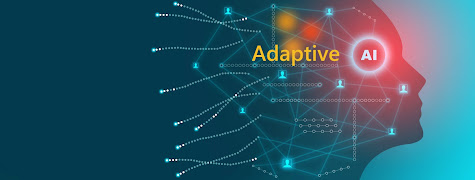Adaptive AI systems support a decision-making framework centered around making faster decisions while remaining flexible to adjust as issues arise. These systems aim to continuously learn based on new data at runtime to adapt more quickly to changes in real-world circumstances. The AI engineering framework can help orchestrate and optimize applications to adapt to, resist or absorb disruptions, facilitating the management of adaptive systems.
Adaptive AI is the latest form of artificial intelligence that learns, adapts and improves as it encounters changes, both in data and the environment.
While more traditional forms of AI follow set rules and algorithms and tend to fall apart when faced with obstacles, adaptive AI systems can modify their behavior based on their experiences. It adjusts its own code without input from a person, providing a level of adaptability and business resilience not seen before. This enables AI to deliver better outcomes faster.
Some key characteristics that distinguish adaptive AI systems are:
- Ability to learn. Machine learning algorithms allow the technology to process and analyze new information. As a result, adaptive AI can acquire knowledge, identify patterns and make predictions.
- Adaptability. Adaptive AI systems adjust their algorithms and decision-making processes when they encounter changes in input data or the context in which they operate. This flexibility makes them practical and relevant even in dynamic and unpredictable situations.
- Self-improvement. Systems improve their capabilities over time by analyzing their own performance, identifying weak or inefficient areas and refining their algorithms in response.
- Problem-solving capabilities. Adaptive AI systems develop sophisticated and nuanced approaches to problems by learning from experience and adapting to new information. These enhanced problem-solving capabilities often surpass traditional AI systems, leading to more innovative solutions to even the most challenging issues.
Key components of Adaptive AI
Machine learning algorithms
These algorithms allow AI systems to learn from data and make predictions or decisions based on their learning. Machine learning is categorized into three main types:
- Supervised learning. This is where the system receives labeled data and learns to map input data to known outputs.
- Unsupervised learning. The system learns patterns and structures in unlabeled, often identifying hidden relationships or clustering similar data points.
- Reinforcement learning. Through trial and error, the system adjusts its actions based on feedback in the form of rewards or penalties.
Neural networks and deep learning
The structure of the human brain inspired the creation of neural networks, which have interconnected layers of nodes or neurons. Deep learning involves using large neural networks with multiple layers to learn complex patterns and representations in data. AI systems learn hierarchical features with these techniques and perform tasks such as image and speech recognition, natural language processing and more.
Transfer learning and meta-learning
AI systems leverage the knowledge it learns from one task or domain and apply it to another related one with transfer learning. It significantly reduces the required training to speed up the learning process.
Meta-learning, sometimes called learning to learn, trains AI systems to optimize their learning algorithms, improving their ability to learn new tasks or adapt to changing environments.
Evolutionary algorithms
These algorithms use natural selection and involve optimization through successive generations of candidate solutions. Adaptive AI uses evolutionary algorithms to optimize AI models, select features and tune hyperparameters, enhancing the system’s adaptability and performance.
Working together, these components enable adaptive AI systems to learn from experience, adjust based on new information, and continually improve performance over time.
Real-world applications of Adaptive AI
The healthcare industry
Adaptive AI will likely prove to be lifesaving and can improve how the healthcare industry functions. Because it can analyze data related to millions of patient vital signs and symptoms, it can optimize disease diagnoses and treatment. Patients can get the most accurate diagnosis and treatment that considers their individual needs and challenges.
It can take vital factors such as disease prevalence to fine-tune its performance and learn the subtle differences between healthcare institutions, like how often they perform blood tests which would be challenging for medical providers to calculate.
Finance
As finance becomes more digital, adaptive AI has the potential to transform how the financial industry runs. For example, Equifax uses it to assess customer risk with deep learning of customer behavior. By studying each customer’s financial decisions over the past 24 months, it approved 92,000 more loans — without any more losses.
In addition to risk management, adaptive AI offers more effective fraud detection by learning customer patterns and identifying anomalies. It can alert institutions faster than ever without inconveniencing customers.
Manufacturing
Organizations can optimize their supply chain using adaptive AI. Algorithms analyze market trends and sales data to predict demand and give manufacturers and leaders deeper insights into production, inventory and distribution. With optimized inventory, companies can avoid shortages and overstocking their warehouses.
Adaptive AI also predicts when equipment will fail, minimizing failures and enabling proactive maintenance. It also predicts other potential risks by analyzing:
- Delivery times
- Supplier performance
- Economic indicators
This way, leaders can proactively tackle threats and minimize disruption to the supply chain.
Environmental sustainability
By analyzing complex climate data, adaptive AI can create more accurate models to predict climate change impacts. With these advanced models, policymakers make informed decisions about mitigation and adaptation strategies, such as:
- Setting emissions reduction targets.
- Planning for sea-level rise.
Adaptive AI also can optimize farming practices to reduce waste. Cameras, drones and sensors use AI to scan fields and detect areas over- or under-irrigated, pests, crop diseases, and vital soil health to eliminate the need for helicopters and enhance food security. These tools help farms improve resource management while reducing the environmental impact of waste.






No comments:
Post a Comment